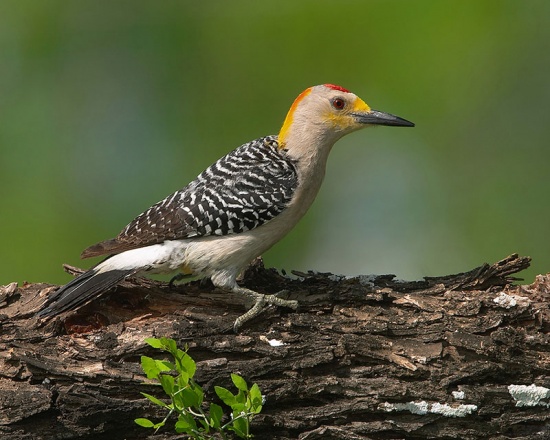- Melanerpes aurifrons
Includes: Velasquez's Woodpecker
Identification
9 1/2" (24 cm)
Barred with black and white above and buff below, nape orange; forecrown yellow.
Female lacks red on crown, but has orange nape. It is the most commonly observed woodpecker in much of Mexico and northern Central America.
Variation
In southern part of its range the nape is red and not yellow, and in the Yucatan (Mexico) all yellow to golden is replaced by red; in this area, the barring on the back is also finer than in the USA
Similar Species
Red-bellied Woodpecker, which differs in nape color in the area of overlap. Yucatan Woodpecker is a relevant comparison in the southeastern part of the range.
Distribution
Resident from southwestern Oklahoma and central Texas down through Mexico and all of northern Central America to Nicaragua.
Taxonomy
The species name aurifrons is Latin for "gold-fronted"
Subspecies
Twelve subspecies occur throughout its range[1]:
- M. a. aurifrons: Lowlands of south-western Oklahoma and north-western Texas to south-central Mexico
- M. a. grateloupensis: Eastern Mexico (Tamaulipas and San Lu¡s Potos¡ to Puebla, Veracruz)
- M. a. veraecrucis: Atlantic slope: Eastern Mexico (Veracruz) to north-eastern Guatemala
- M. a. dubius: Southern Mexico (Yucatan Peninsula) to north-eastern Guatemala and Belize
- M. a. leei: Cozumel Island (off eastern Mexico)
- M. a. turneffensis: Turneffe Islands (off Belize)
- M. a. santacruzi: South-eastern Chiapas to El Salvador, south-western Honduras and north-central Nicaragua
- M. a. hughlandi: Guatemala (upper R¡o Negro and upper Motagua Valley)
- M. a. pauper: Coastal northern Honduras
- M. a. insulanus: Utila Island (off northern Honduras)
- M. a. canescens: Roat n Island and Barbareta Island (off northern Honduras)
- M. a. polygrammus: Arid south-western Mexico (south-western Oaxaca through interior Chiapas)
A hybrid zone occurs with the closely related Hoffmann's Woodpecker in southern Honduras. Some authors have suggested that they should be considered as one species. Other authors have suggested treating some of the subspecies as separate species, eg the santacruzi group (from Yucatan Peninsula including Honduras and Guatemala, and from surrounding islands) as Velasquez's Woodpecker.
Habitat
Open woods in dry country and river bottoms with trees.
This familiar woodpecker is common in the parks and shade trees of central and west Texas towns and cities.
Behaviour
Breeding
Nesting: 4 or 5 white eggs in holes in mesquite trees, poles, and posts.
Vocalisation
Loud churrrr.
Call: a burry chuck-chuck-chuck.
References
- Clements, J. F., T. S. Schulenberg, M. J. Iliff, B.L. Sullivan, C. L. Wood, and D. Roberson. 2013. The eBird/Clements checklist of birds of the world: Version 6.8., with updates to August 2013. Downloaded from http://www.birds.cornell.edu/clementschecklist/download/
- Avibase
- BF Member observations
Recommended Citation
- BirdForum Opus contributors. (2025) Golden-fronted Woodpecker. In: BirdForum, the forum for wild birds and birding. Retrieved 18 May 2025 from https://www.birdforum.net/opus/Golden-fronted_Woodpecker
External Links
GSearch checked for 2020 platform.1







